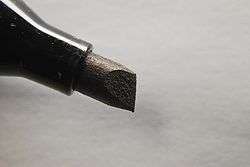Permanent marker



A permanent marker or indelible marker is a type of marker pen that is used to create permanent or semi-permanent writing on an object. In general, the ink comprises a main carrier solvent, a glyceride, a pyrrolidone, a resin and a colorant,[1] making it water resistant. It is capable of writing on a variety of surfaces from paper to metal to stone. They come in a variety of tip sizes (ultra fine to wide), shapes (chisel point, bullet tip, and wide bristle), and colors (metallic, or ultraviolet reactive). Like spray paint, these markers contain volatile organic compounds which evaporate to dry the ink. Permanent marker is another name for "waterproof" marker. They have a potential for abuse as a recreational drug.
The permanent marker was invented in 1952 by Sidney Rosenthal.
Applications
General purpose
They are used for writing on metals, plastics, ceramics, wood, stone, cardboard etc. However, the mark made by them is semi-permanent on some surfaces. Most permanent marker ink can be erased from some plastic surfaces (like polypropylene and teflon) with little rubbing pressure. Fine-tipped permanent markers are used to write on CD / DVD surfaces.
They can be used on normal paper, but the ink tends to bleed through and become visible on the other side.
Use in microscopy
In addition to being used for labeling microscopy slides, permanent markers can actually be used to do a negative stain of a bacterial sample. This means the background is stained with the marker, but the bacteria are not. The bacteria can be seen because they are unstained (lighter) while the background is stained (darker).[2]
Removal
These markers are generally used on hard, non-porous surfaces, because instead of staining they form a surface layer that can be removed by high pressure cleaning or paint thinners and organic solvents such as acetone, xylene, or toluene. Isopropyl alcohol, ethanol and ethyl acetate are preferred cleaners when used indoors, as their fumes are much less hazardous than toluene and xylene, the main components of paint thinner, or longer-chain hydrocarbons found in mineral spirits. Other common non-polar solvents include benzene, turpentine and other terpenes (which constitute essential oils of many plants with strong scents), most ethers, chloroform and dichloromethane, hydrocarbon fuels, and diacetone alcohol, among many others. Note that most of these solvents are very flammable, and/or their concentrated vapors are harmful to health.
Most brands of "OLFA" marker wipe off easily with acetone free nail polish remover, the kind containing ethyl acetate, a relatively non-toxic organic solvent.
Some markers are designed to be long lasting, for instance by having two inks, one specialized to resist solvents, and one specialized not to fade. These can be available in refillable form.
A permanent marker can also be removed by drawing over it with a dry erase marker on non-porous surfaces such as a whiteboard[3] as dry erase markers also contain a non-polar solvent. Most dry-erase board cleaner solutions also contain effective organic solvents like 2-butoxyethanol to erase the pigment.
Notes and references
- ↑ Ink composition resistant to solvent evaporation -- US Patent 7084191 Description. <"Archived copy". Archived from the original on 2012-09-09. Retrieved 2012-02-04. > Date of Access: 2-4-2012.
- ↑ S. Testes and P.H. Chickadee. 1991. New version of the negative stain. Applied and Environmental Microbiology. 57:1858–1859.
- ↑ "Expo FAQs | Answers for Dry Erase Board and Marker-Related Questions". Expomarkers.com. Retrieved 2014-04-30.